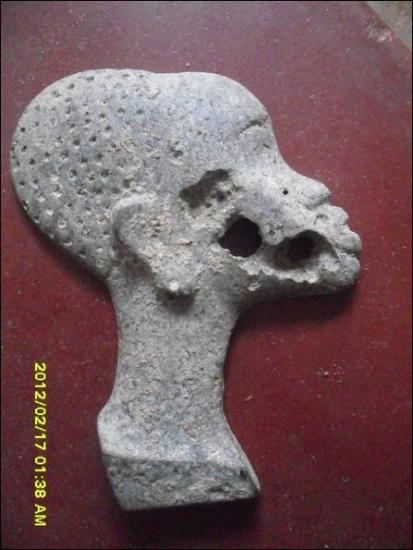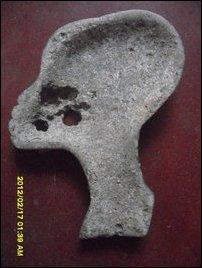African Art found in Kayts Island off Jaffna
Source - http://www.tamilnet.com/art.html?catid=79&artid=34949
Head part of a metal sculpture showing features of African Art, discovered while digging a well at Allaippiddi in the Kayts Island off Jaffna, has been brought to the notice of professionals in archaeology by the efforts of a local teacher Nadarajah Vakeesan of Bharathi Vidyalayam. The artefact, found in the Palk Bay side of Kayts, an ancient as well as colonial harbour island, where pottery dating from pre-Christian centuries, a hoard of Chola artefacts and a cargo of Chinese ware dated to 12th century CE have been found earlier, and where some early Islamic and European colonial monuments are also located, now shows its Black African connections too, academics said.

The piece of African art found at Allaippiddi in the Kayts Island of Jaffna
The sculpture, 14cms in height and 12cms in width is yet to be ascertained of its metal content, said Prof. P. Pushparatnam of the University of Jaffna, talking to media on the artefact acquired by archaeology field officers P. Kapilan and S. Manimaran.
Prof. Pushparatnam was citing the protruding jaw, thick lips, receding forehead, stylized curly hair, the back of the head and the long neck, in linking the sculpture to African Art.
Many African communities, especially from the Horn part of East Africa and Northern Africa in the ancient and medieval times, and many other Africans during the colonial times, were in contact with southern parts of maritime South Asia due to mercantile, mercenary, religious and labour reasons.

The inner side of the moulded halve of the figure
The long neck depicted in the sculpture is considered a sign of beauty by many African peoples. The finish just at the shoulder probably means that the sculpture was originally designed like that. But, what has been found is only one halve of the moulded image, as could be seen from the photo of its other side. The two perforations on the face and another attempted one are deliberate.
In the absence of context and typological studies it is difficult to say when and from which part of Africa the sculpture had come to Jaffna, but, there are strong literary and folk evidences available in Jaffna for the peninsula’s contacts with an African people identified by the name Papparavar, at least in the times of the Kingdom of Jaffna, academics said.
Papparavar is a mercenary soldier community that had come to Jaffna, according to historiographical literature Vaiyaapadal that was written in the times of the Kingdom of Jaffna. It seems later they took to fishing.
Even though the identity of the community is not found in the caste system of Jaffna today, there are at least some place names that remind us of the settlements of the Papparavar. Vaiyaapaadal places them under the Pa’l’luvili caste.
The land where the Nayinaa-theevu Amman temple stands today is known in its land deeds as Papparavan Challi (meaning the shelly land of a Papparavan). The temple is located in an archaeological site. Nayinaa-theevu, which is an adjacent island of Kayts was also sometimes called as Papparavath-theevu (the island of Papparavar: vide, the family chronicles of the Kaarainakar temple priests; Aanma Tharsanam, Ka’napatheesvarak-kurukka’l memorial volume, published in 1969).
Another related place name is Papparavap-piddi (the coastal high ground of Papparavar), north of Chaalai in the sand bar that links the Jaffna Peninsula with the main island. This is also an archaeological site.
Pappara-theasam and Papparavar are general references to Africa and its black people in the Tamil lexicons and as implied through corroborative evidences available in the neighbouring languages. In Sanskrit, Babhroo is a country associated with people of curly hair and deep brown colour. Related terms Barbar in old Greek and Arabic and Berber in later European languages, referred to people of the Berber territory of the Western part of North Africa, i.e., Morocco.
Morocco played a significant role in trade, geographical voyages, Islamic missions and mercenary soldiers in the pre-European medieval times of maritime South Asia. Ibn Battuta, who met the king of Jaffna during his travels in mid 14th century, had come from Morocco. Many of the early missions of maritime Islam of a particular mystic school associated with Dargahs that had come to South India, Maldives and to the island of Sri Lanka, originated from Morocco.
Ma’nkumpaan near Allaippiddi in Kayts and the Nayinaatheevu Island have some early Muslim monuments associated with the Dargah tradition.
However, the sculpture of African Art found at Allaippiddi, could neither belong to Islam nor to the hybrid Arab cultures of North Africa. It is Black African, academics said.
Vaiyaapaadal makes a differentiation of Papparavar and Choanakar–whether Muslims or not– and mentions them with separate identity, when it lists out the mercenary soldier groups that had come to Jaffna. Choanakar are generally the Arabs.
For more details on the African community of Papparavar in Jaffna and on the etymology of the term in Tamil, Sinhala, Maldivian and Sanskrit, see the column on Papparavap-piddi appeared in TamilNet on 22 February 2008.
The Kayts Island, due to its location facing the Palk Strait and guarding the entrances into the Jaffna Lagoon, was in the hub of maritime contacts since very early times.
Pre-Christian pottery sites, probably of protohistoric period, have been found in the island at Chaaddi and Kumpu’rup-piddi (Ragupathy 1983, Pushparatnam 2004). In the 1960s the then curator of the Jaffna museum, Mr. M.P. Selvaratnam acquired a hoard of Chola artefacts found at Naaraanthanai in Kayts. In 1971, Prof K. Indrapala discovered a Chola inscription at the fort off Kayts and in1977 Prof John Carswell found a cargo of Chinese ware at Allaippiddi.
Kayts has got its name from the Portuguese Cais, meaning harbour.
The Tamil name of the harbour, Ooraath-thurai (as found written in the Tamil inscriptions of 12th century CE and as used in the speech of the local people), means the harbour of a particular type of sail-ships.